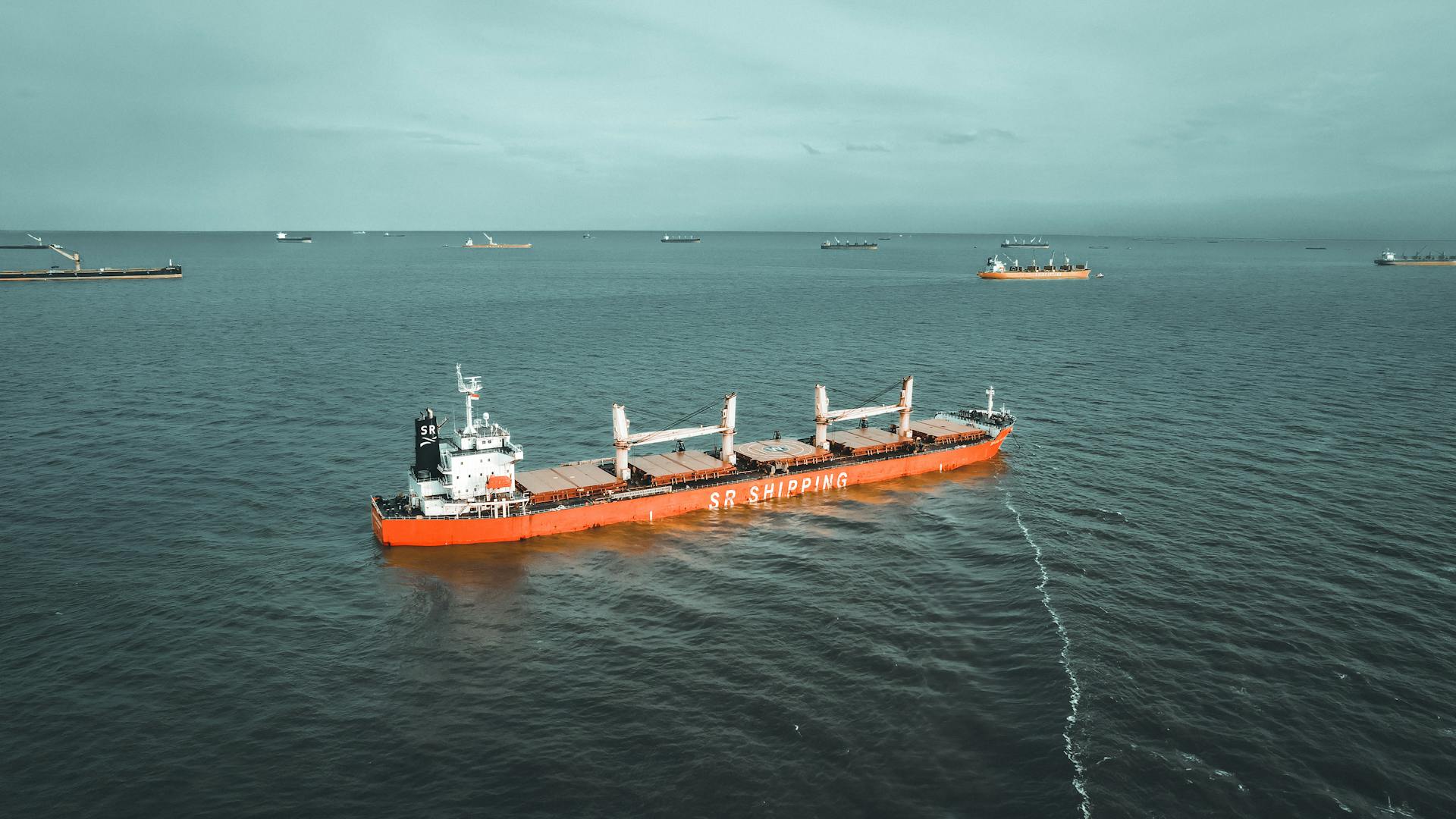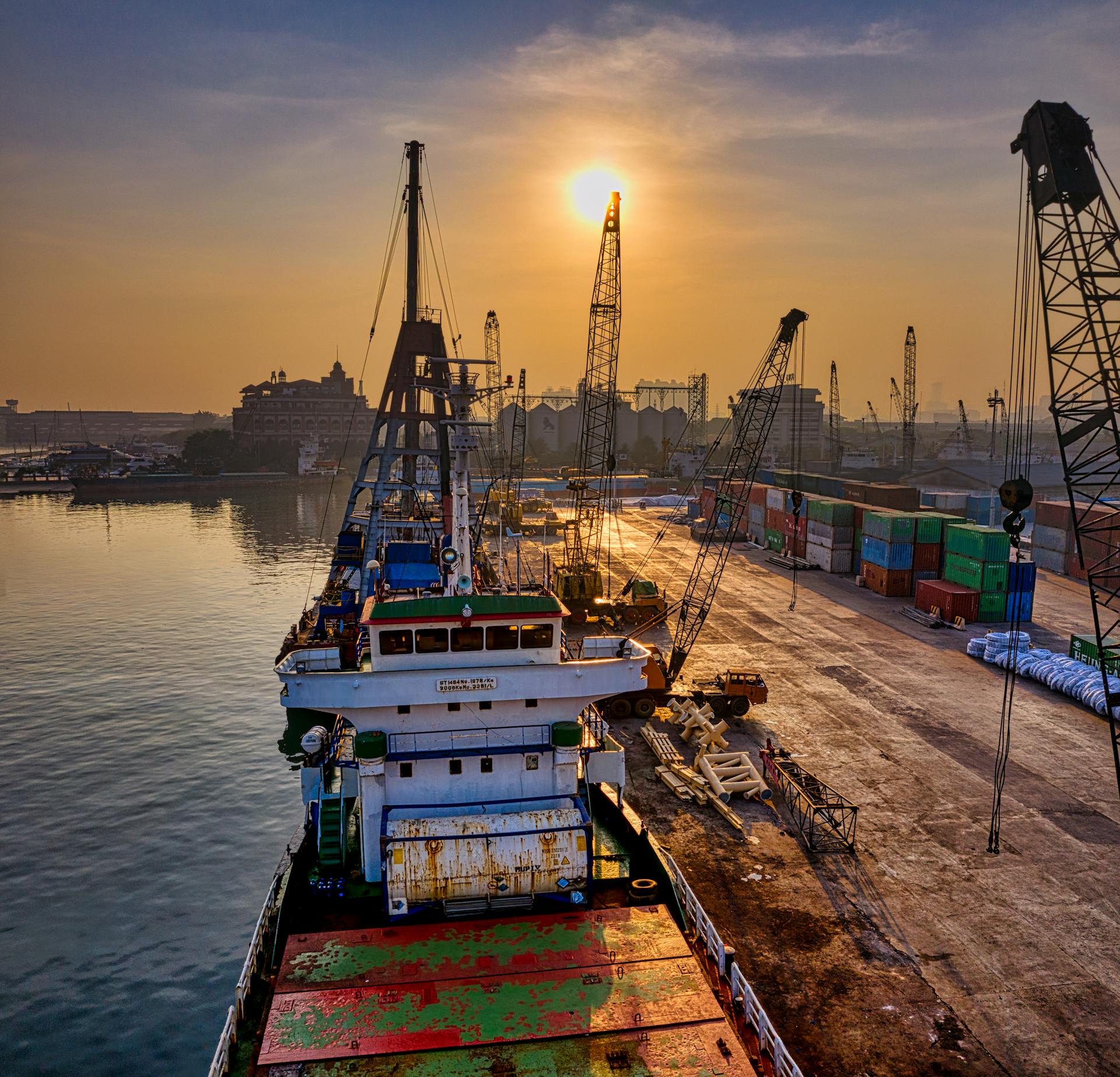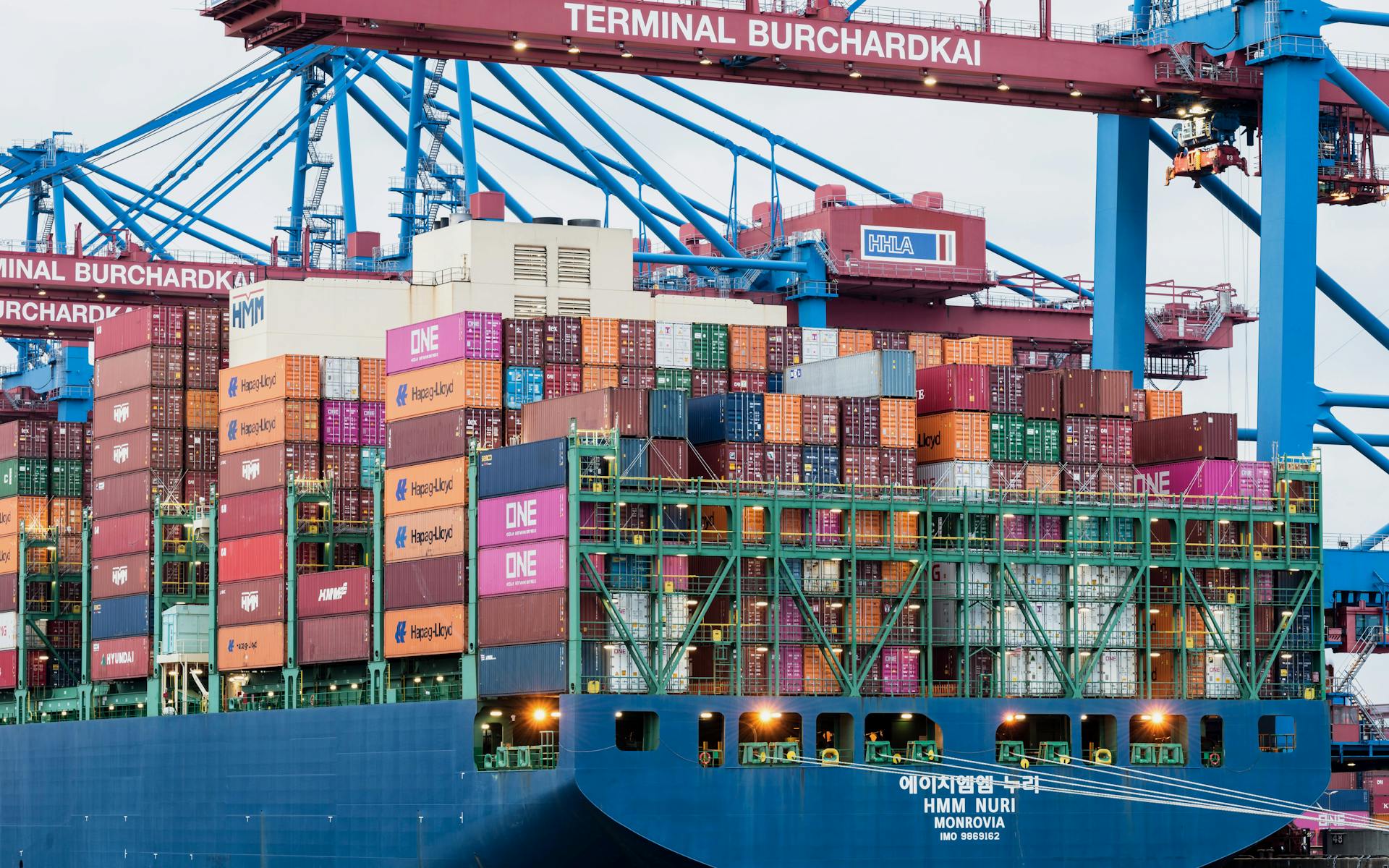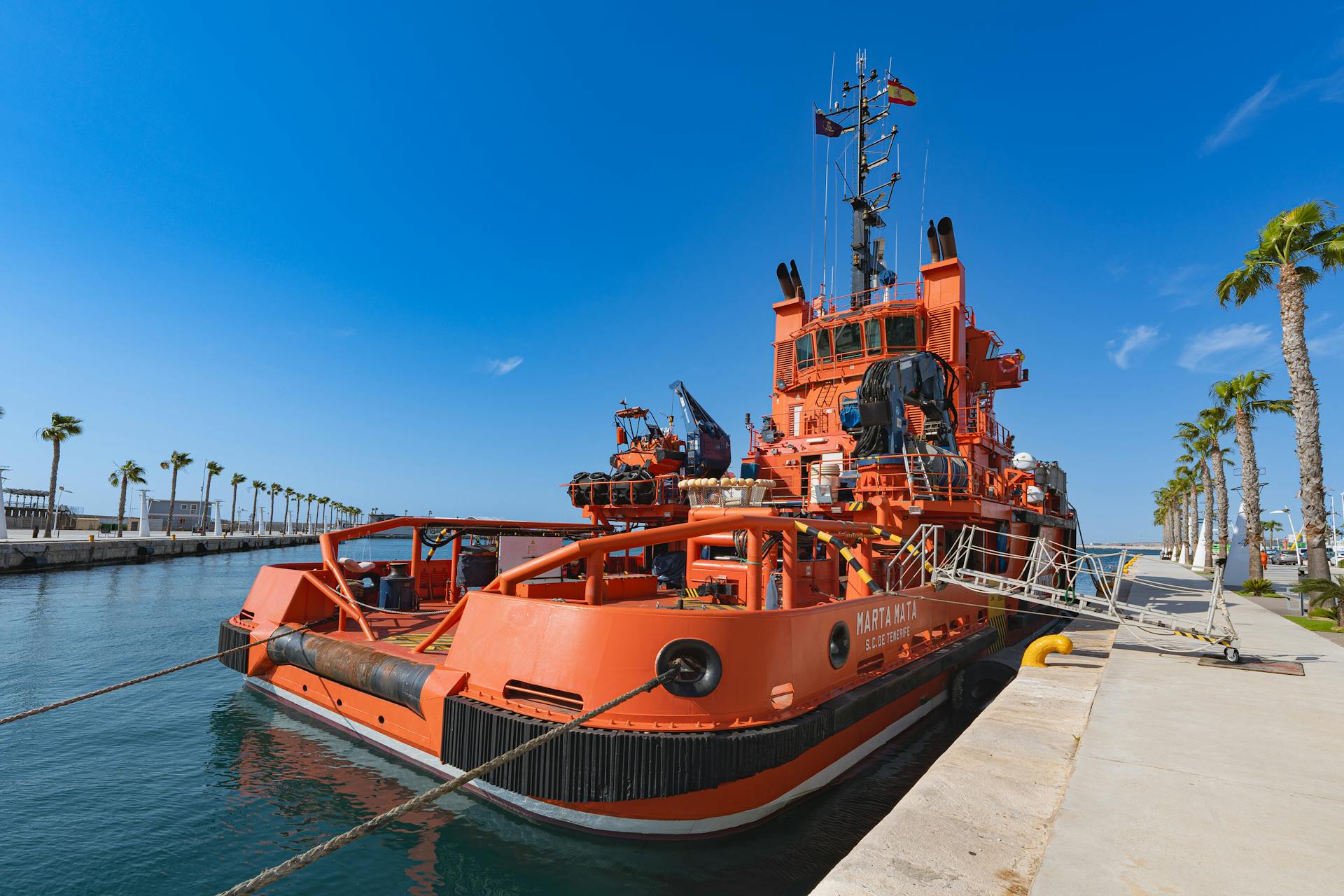
A cargo ferry boat is a vessel designed to transport goods, vehicles, and even people between two locations, often in coastal or inland waterways.
These boats are typically larger than a standard ferry, with a capacity to carry a significant amount of cargo.
They usually have a flat deck to accommodate vehicles and containers, as well as cranes or other equipment for loading and unloading cargo.
Cargo ferry boats can be found in various parts of the world, including the United States, Europe, and Asia, serving as an essential link in the global supply chain.
Ferry Information
So, you're looking to get some information about cargo ferries. Here's the lowdown:
A cargo ferry's route and network are crucial factors to consider. Ensure it covers the destinations where goods need to be shipped.
A ferry with a comprehensive network can offer more flexible and reliable services, connecting to major ports and key markets.
When examining a cargo ferry's capacity, consider both weight and volume. It should be suitable for the size and type of goods to be transported.
Some cargo ferries have specialized equipment for handling specific types of cargo, such as containers or perishables.
Transit times are also important, and you should evaluate the cargo ferry's transit times to ensure they align with your delivery schedules.
Ferries generally offer competitive transit times, but it's essential to choose one that meets your needs.
Here are some key factors to consider when evaluating transit times:
- Frequency of sailings
- Historical punctuality records
Reputation and reliability are also vital when choosing a cargo ferry. Research the service's reputation by reading customer reviews and checking industry ratings.
A ferry with a strong track record of safety, reliability, and good customer service is essential for smooth operations.
Make sure the cargo ferry adheres to all relevant maritime regulations and possesses the necessary licenses.
It's also essential to check the insurance coverage provided by the ferry operator to protect the cargo against loss, damage, or theft during transit.
Customer support is another crucial aspect to consider. Look for a ferry with efficient communication, responsive support teams, and tracking capabilities.
Choosing and Reserving
Choosing a cargo ferry boat requires careful consideration of its capacity. A typical cargo ferry can carry between 20 to 40 vehicles at a time.
When selecting a ferry, consider its size and weight capacity. The average cargo ferry has a gross tonnage of around 2,000 tons.
For a smooth and efficient experience, make sure to reserve your spot on the ferry in advance. This ensures that you have a spot on the ferry, especially during peak travel seasons.
Choosing Ferries
Choosing the right ferry service is crucial for a smooth and efficient journey. It's essential to consider the ferry's established routes and network to ensure it covers the destinations where you need to go.
Research the cargo ferry's capacity regarding weight and volume to ensure it's suitable for the size and type of goods or vehicles you're transporting. Consider the ferry's specifications, such as deck height, type of loading equipment, and storage conditions.
Evaluate the cargo ferry's transit times to ensure they align with your required delivery schedules. Consider factors like frequency of sailings and historical punctuality records.
Get detailed quotations from different cargo ferries and compare their pricing structures. Look beyond the base fare and consider additional costs such as fuel surcharges, terminal fees, and insurance.
Research the reputation and reliability of the cargo ferry service by reading customer reviews, checking industry ratings, and seeking recommendations from trusted sources.
Ensure the cargo ferry adheres to all relevant maritime regulations and possesses the necessary licenses. Check the insurance coverage provided by the ferry operator to protect the cargo against loss, damage, or theft during transit.
Consider the level of customer support offered by the cargo ferry service, including efficient communication, responsive support teams, and tracking capabilities.
Here's a quick reference guide to help you choose a ferry service:
By considering these factors and doing your research, you can choose a ferry service that meets your needs and ensures a smooth and efficient journey.
Car Reservation

Making a car reservation for the cargo ferry is a must, especially if you're a small island local. Reservations are limited to locals and can only be made at the ticket window.
You'll want to plan ahead and reserve your spot early, as reservations are required for cars/cargo on the cargo ferry.
If you're planning to bring your vehicle, be sure to arrive at the loading dock at least an hour before your reserved departure time.
Loading Your Stuff Onto the Ferry
Be at the loading dock early, ideally 1 hour before departure, or you'll lose your spot. If you're late, they won't hold the ferry for you.
Cargo trucks get priority, so even with a reservation, passenger cars may get bumped, leaving you stranded. This can mess up your plans, so be prepared for that possibility.
The loading process can take a while, and you might need to wait until everyone is loaded before you can depart. This can be frustrating, but it's just part of the process.
To load your vehicle, you'll need to bring it to the ship and follow the instructions of the workers. They'll tell you when and where to load, and you'll need to hang around until everyone is loaded.
Here are the estimated travel times for cargo ferries:
Keep in mind that these times are estimates, and the actual travel time may vary depending on the circumstances.
Ferry Design and Operations
The ferry's design and operations are impressive, with a length of 126 meters and a breadth of 22 meters. This allows it to carry a significant amount of cargo and passengers.
The ferry is equipped with 2 propellers, which enable it to cruise at a speed of 15 knots. This is a great feature for transporting goods and people across the water.
The vessel's capacity is quite impressive, with 3000 tons of freight and 230 passengers that can be accommodated. This is made possible by the various types of staterooms and dormitories available.
Here's a breakdown of the different types of accommodations on board:
- Double staterooms: 30 in total, each with a size of 11 sqm
- Single staterooms: 2 in total
- Quadruple staterooms: 6 in total
- Dormitories: 5 in total, accommodating 4 to 8 persons each
This variety of accommodations ensures that there's something for everyone, whether you're traveling solo or with a group.
Types of Ferries
Cargo ferries come in different types, each tailored to specific cargo transportation needs and requirements. One of the most common types of cargo ferries is the roll-on/roll-off (RoRo) ferry, which is designed to carry wheeled cargo such as trucks, cars, trailers, and other vehicles.
RoRo ferries have a specialized ramp that allows vehicles to roll on and off the ferry easily, making the loading and unloading process fast and efficient. This is the most widely used cargo ferry.
Another type of cargo ferry is the lift-on/lift-off (LoLo) ferry, which is designed to carry various types of cargo, including containers, pallets, and other goods. LoLo ferries have a crane or lift system that allows cargo to be lifted on and off the ferry.
Cargo ferries also vary in size and capacity. Some ferries are relatively small and can carry a limited amount of cargo, while others are large and can carry a significant amount of cargo. The size and capacity of a cargo ferry depend on various factors, including the type of cargo being transported, the distance of transportation, and the demand for cargo transportation services.
Here are some key features of different types of cargo ferries:
Specialized ferries are designed for specific types of cargo, such as liquid cargo and perishable goods. These ferries have the necessary equipment and safety features to ensure the secure transportation of these types of cargo.
Functions and Design of Combined Ferries
Combined ferries are designed to transport a variety of goods, from vehicles to containers and even animals. They come in different types, each with its own unique features and designs.
Roll-on/Roll-off (RoRo) cargo ferries are perfect for transporting vehicles that can drive on and off the ferry using a ramp. This streamlined operation process makes it easy to load and unload goods.
Lift-on/Lift-off (LoLo) cargo ferries, on the other hand, are designed for carrying containers and breakbulk cargo. They use cranes to lift and move cargo, which requires larger decks and heavy-duty elevators.
Conventional cargo ferries are a bit of a jack-of-all-trades, designed to carry various types of cargo. They have enclosed cargo holds and multiple decks, making them versatile but not specifically suited for any particular type of freight.
Container cargo ferries are designed specifically for transporting containerized cargo. They have large decks equipped with twist-lock mechanisms to secure containers, making them ideal for withstanding rough waters.
Livestock cargo ferries are equipped with specialized facilities for carrying animals, including ventilation systems and multiple decks. This design ensures the comfort and safety of the animals during transportation.
Bulk cargo ferries are designed to transport large amounts of bulk materials like grain, coal, or ore. They have spacious and enclosed cargo holds that can be divided into compartments for different types of materials.
Here are some key features of combined ferries:
Flat Barge for Cars
A flat barge for cars is a type of cargo ferry designed to transport vehicles across water. These ferries are often used for short-distance transportation of cars and other wheeled vehicles.
Flat barges for cars typically have a ramp or a series of ramps that allow vehicles to drive directly onto the ferry. This makes the loading and unloading process fast and efficient, as seen in the RoRo cargo ferries.
The size and capacity of flat barges for cars can vary depending on the type of cargo being transported and the distance of transportation. Some flat barges can carry a limited number of vehicles, while others can carry hundreds of cars.
Here are some key features of flat barges for cars:
Some flat barges for cars are also designed to carry other types of cargo, such as containers or pallets. However, these ferries are most commonly used for transporting wheeled vehicles.
Frequently Asked Questions
What are the boats that carry cargo called?
Cargo ships or freighters are the boats that carry cargo, goods, and materials across the world's seas and oceans. They play a crucial role in international trade, handling the bulk of global cargo shipments.
Can you take a car on the Ceiba ferry?
Yes, you can take a car on the Ceiba ferry, specifically on the cargo-passenger ferries that carry both passengers and cargo.
What are the two types of ferries?
There are two main types of ferries: Hydrofoil and Cruiseferry/RoPax, each offering distinct advantages in terms of speed and capacity.
Featured Images: pexels.com


